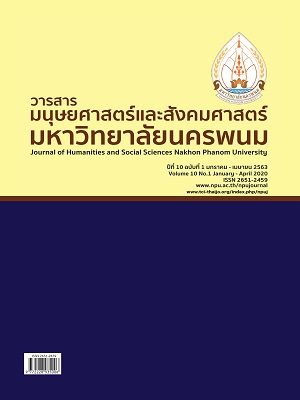The Development of Indicators on Professional Learning Community Building in Schools under Nakhon Phanom Primary Educational Service Area Office 2
Main Article Content
Abstract
The objectives of this study were to 1) develop professional learning community building indicators in schools under Nakhon Phanom Primary Educational Service Area Office 2 and 2) examine the goodness of fit between the author's structural model on professional learning community building indicators in schools under Nakhon Phanom Primary Educational Service Area Office 2 with the empirical data. The study was divided in 2 phases. The indicators on professional learning community building was developed in the first phase by an analysis of relevant research papers and interviewing experts to build the conceptual framework and to draft the indicators, using content analysis method. Consequently, the construct validity examination of the developed model with the empirical data was carried out in the second phase. Data was collected by the sample group of 508 school directors and teachers under Nakhon Phanom Primary Educational Service Area Office 2 in academic year B.E. 2561, selected through multi-stage random sampling. The tool employed in data collection was a 5-level rating scale questionnaire with content validity index between 0.60 – 1.00, the overall reliability value as determined by using Cronbach Alpha Coefficient at 0.98 and discrimination value between 0.42–0.89. Statistics used in data analysis were frequency, percentage, mean, standard deviation, Pearson product moment correlation and confirmatory factor analysis, conducted with the employment of statistical software.
The results are as follows: 1) there are 5 main components, 18 sub-components and 73 indicators in building a successful professional learning community, which can be classified into 1.1) 17 indicators on team work; 1.2) 11 indicators on shared vision; 1.3) 15 indicators on organizational culture; 1.4) 18 indicators on the leadership of school directors and teachers and 1.5) 12 indicators on knowledge sharing between community members and 2) the author's structural model on the indicators on professional learning community building in schools under Nakhon Phanom Primary Educational Service Area Office 2 shows congruence with the empirical data, with chi - square at 87.70 with no statistically significance, df = 89, p-value = 0.52, x2 / df = 0.99, GFI = 0.98, AGFI = 0.96, RMSEA = 0.00, CN = 708.20, which are in accordance with the set hypothesis. The factor loading of each main component can be prioritized from the highest to lowest as leadership of school directors and teachers (.99); knowledge sharing between community members (.96); shared vision (.95); organizational culture (.95) and team work (.91).
Article Details
References
ดารุณี บุญครอง. (2560). วิเคราะห์แนวทางการจัดการศึกษาไทยกับการขับเคลื่อนการศึกษาสู่ยุคไทยแลนด์ 4.0. สารอาศรมวัฒนธรรมวลัยลักษณ์, (2), 5-6.
นงลักษณ์ วิรัชชัย และคณะ. (2551). การพัฒนาตัวบ่งชี้การประเมิน. การประชุมวิชาการ เปิดขอบฟ้าคุณธรรม จริยธรรม.กรุงเทพฯ: โรงแรมแอมบาสเดอร์.
พิมพ์พันธ์ เดชะคุปต์. (2558). การจัดการเรียนรู้ในศตวรรษที่ 21 (พิมพ์ครั้งที่ 2). กรุงเทพฯ: โรงพิมพ์แห่งหนึ่งจุฬาลงกรณ์มหาวิทยาลัย.
รัฐธรรมนูญแห่งราชอาณาจักรไทย. (2560). ราชกิจจานุเบกษา. 134 (ตอนที่ 40ก). หน้า 14.
วรลักษณ์ ชูกำเนิดและเอกรินทร์ สังข์ทอง. (2557). โรงเรียนแห่งชุมชนการเรียนรู้ทางวิชาชีพครู เพื่อการพัฒนาวิชาชีพครูที่เน้นผู้เรียนเป็นหัวใจสำคัญ. วารสารวิทยบริการมหาวิทยาลัยสงขลานครินทร์, 25(1), 93-102.
วิทูล ทาชา. (2559). การพัฒนาอีเลิร์นนิ่งเพื่อชุมชนการเรียนรู้ทางวิชาชีพ : กรณีการวิจัยเชิงปฏิบัติการแบบมีส่วนร่วมในมหาวิทยาลัยมหามกุฏราชวิทยาลัยวิทยาเขตอีสาน. วิทยานิพนธ์ศึกษาศาสตรดุษฎีบัณฑิต. ขอนแก่น : มหาวิทยาลัยมหามงกุฏราชวิทยาลัย.
สมุทร สมปอง. (2558). การพัฒนารูปแบบการสร้างชุมชนการเรียนรู้ทางวิชาชีพครูในโรงเรียนประถมศึกษา. วิทยานิพนธ์ การศึกษาดุษฎีบัณฑิต. มหาสารคาม : มหาวิทยาลัยมหาสารคาม.
อาบูบักรี การี. (2557). ภาวะผู้นำการเปลี่ยนแปลงของผู้บริหารในสถานศึกษาเอกชน อำเภอเบตง จังหวัดยะลา. วิทยานิพนธ์ครุศาสตรมหาบัณฑิต. ยะลา : มหาวิทยาลัยราชภัฏยะลา.

